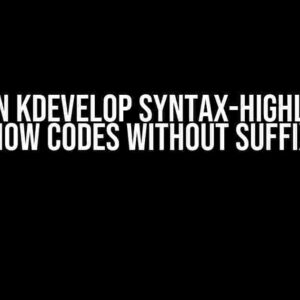Are you tired of encountering those pesky IAudioClient::Initialize return values and wondering what they mean? Well, wonder no more! In this article, we’ll delve into the world of audio clients and explore the differences between two seemingly mysterious return values. By the end of this journey, you’ll be well-equipped to handle any audio client initialization woes that come your way.
What is IAudioClient::Initialize?
Before we dive into the differences, let’s quickly review what IAudioClient::Initialize does. This method initializes an audio client, preparing it for use. It’s a crucial step in audio processing, as it sets up the audio client with the required parameters, such as the audio format, buffer size, and more.
HRESULT Initialize(
[in] AUDCLNT_SHAREMODE ShareMode,
[in] DWORD dwFlags,
[in] constWAVEFORMATEX *pFormat,
[in] HANDLE hnsysprt,
[in] DWORD *pdwInitializationFlags,
[out] IAudioCaptureClient **ppCaptureClient
);
The Enigmatic Return Values
Now, let’s get to the heart of the matter. IAudioClient::Initialize can return two possible values: S_OK and S_FALSE. But what do they mean, and how do you handle them?
S_OK: The Golden Ticket
A return value of S_OK indicates that the audio client was successfully initialized. This is the ideal scenario, where everything went smoothly, and you can proceed with using the audio client without any issues.
In this case, you can safely ignore the return value and continue with your audio processing tasks. However, it’s still essential to check for errors, as other methods might fail even if initialization succeeds.
S_FALSE: The Plot Thickens
A return value of S_FALSE, on the other hand, indicates that the audio client was initialized, but with some limitations. This might occur when the audio device is already in use or if the requested format is not supported.
In this scenario, you should investigate the cause of the limitation and adjust your audio client settings accordingly. You might need to:
- Check the audio device’s availability
- Modify the audio format to a compatible one
- Implement alternative audio processing methods
It’s crucial to understand that S_FALSE doesn’t necessarily mean failure. It’s an opportunity to adapt and find a solution that works for your specific use case.
Common Scenarios and Solutions
To help you better understand the differences between S_OK and S_FALSE, let’s explore some common scenarios and their corresponding solutions:
| Scenario | Return Value | Solution |
|---|---|---|
| Audio device is in use | S_FALSE | Check device availability and try again or use an alternative device |
| Requested format is not supported | S_FALSE | Modify the audio format to a compatible one or use a different audio client |
| Initialization succeeds | S_OK | Proceed with audio processing tasks |
| Initialization fails due to system resource constraints | S_FALSE | Optimize system resources or reduce the number of active audio clients |
Best Practices for Handling IAudioClient::Initialize Return Values
To avoid common pitfalls and ensure seamless audio client initialization, follow these best practices:
- Always check the return value of IAudioClient::Initialize
- Handle S_FALSE return values by investigating the cause and adjusting your audio client settings accordingly
- Implement error-handling mechanisms for other audio client methods, as they might fail even if initialization succeeds
- Optimize system resources to minimize the risk of S_FALSE return values
- Test your audio client implementation with different scenarios and edge cases to ensure robustness
Conclusion
In conclusion, the difference between S_OK and S_FALSE return values from IAudioClient::Initialize lies in the level of initialization success. While S_OK indicates a smooth initialization, S_FALSE signals limitations or constraints that require adaptation. By understanding these return values and following best practices, you’ll be well-equipped to handle any audio client initialization challenges that come your way.
Remember, in the world of audio clients, flexibility and adaptability are key. So, don’t be afraid to dig deeper and explore the intricacies of IAudioClient::Initialize return values. Your audio processing tasks will thank you!
Happy coding, and may the audio signals be ever in your favor!
Frequently Asked Question
Are you curious about the difference between two IAudioClient::Initialize return values? Let’s dive in and explore the most common questions and answers!
What does the return value S_FALSE indicate in IAudioClient::Initialize?
S_FALSE indicates that the audio client has been initialized, but the AUDCLNT_SHAREMODE_EXCLUSIVE flag was not granted. This means that the client will not have exclusive access to the audio device, and other applications may be able to access the device simultaneously.
What does the return value S_OK indicate in IAudioClient::Initialize?
S_OK indicates that the audio client has been successfully initialized, and the AUDCLNT_SHAREMODE_EXCLUSIVE flag was granted. This means that the client has exclusive access to the audio device, and no other applications can access the device until the client releases it.
Can IAudioClient::Initialize return both S_FALSE and S_OK?
Yes, IAudioClient::Initialize can return both S_FALSE and S_OK, depending on the context and the flags specified during initialization. For example, if you specify the AUDCLNT_SHAREMODE_EXCLUSIVE flag but another application has already taken exclusive control of the audio device, IAudioClient::Initialize may return S_FALSE.
What happens if IAudioClient::Initialize returns E_OUTOFMEMORY?
If IAudioClient::Initialize returns E_OUTOFMEMORY, it means that the system has run out of memory to allocate the audio client. This is a rare error, but it can occur if the system is under heavy load or if there are multiple audio clients competing for resources.
Do I need to handle both S_FALSE and S_OK return values in my audio application?
Yes, it’s recommended to handle both S_FALSE and S_OK return values in your audio application to ensure that it can adapt to different scenarios and provide the best possible user experience. By handling both return values, you can ensure that your application can function correctly regardless of whether it has exclusive access to the audio device or not.


